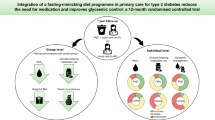Abstract
Objective
To describe the quantitative and qualitative changes in the utilization of oral antihyperglycemic drugs (OAHDs) between 1998 and 2004 and to analyze patients’ adherence to OAHD therapy.
Methods
We conducted a retrospective analysis of the electronic database of the Hungarian National Health Fund Administration for the years 1998 through 2004. All 912,620 prescriptions for OAHDs dispensed for the 38,855 patients in Csongrád County (430,000 inhabitants) were retrieved and analyzed according to the ATC/DDD (World Health Organization) methodology. Nonadherence was set as medication possession ratio <80%.
Results
The number of patients using OAHDs significantly increased (P<0.001); the yearly prevalence of 2.88% in 1998 increased to 4.32% in 2004. The overall consumption of OAHDs increased by 76%, from 20.85 defined daily doses per 1,000 inhabitants per day (DDD/TID) in 1998 to 36.83 DDD/TID in 2004. While in 1998 glibenclamide was the most often prescribed agent, received by 61.7% of patients, its share dropped to 16.1% in 2004, and metformin became the leading agent prescribed for 43.0% of patients. During the study period, the adherence rate varied between 47.9% and 49.2%. Women had a significantly better (P<0.001) adherence rate than men, 51.3% vs. 45.5%. The adherence rate peaked in patients between 60 and 79 years and was lowest in patients in their 30s.
Conclusions
The utilization pattern of OAHDs considerably changed, but there were no significant changes in patients’ adherence. The significant increase in the utilization of OAHDs is not the result of increased adherence but of increased patient number.

Similar content being viewed by others
References
Wild S, Roglic G, Green A, Sicree R, King H (2004) The global prevalence of diabetes. Estimation for the year 2000 and projection for 2030. Diabetes Care 27:1047–1053
International Diabetes Federation (2003) The diabetes atlas. International Diabetes Federation, Brussels
Arteagoitia JM, Larranaga MI, Rodriguez JL, Fernandez I, Pinies JA (2003) Incidence, prevalence and coronary heart disease risk level in known type 2 diabetes: a sentinel practice network study in the Basque country, Spain. Diabetologia 46:899–909
UK Prospective Diabetes Study (UKPDS) Group (1998) Intensive blood–glucose control with sulphonylureas or insulin compared with conventional treatment and risk of complications in patients with type 2 diabetes (UKPDS 33). Lancet 352:837–853
Lau DT, Nau DP (2004) Oral antihyperglycemic medication nonadherence and subsequent hospitalization among individuals with type 2 diabetes. Diabetes Care 27:2149–2153
Balkrishnan R, Rajagopalan R, Camacho FT, Huston SA, Murray FT, Anderson RT (2003) Predictor of medication adherence and associated health care costs in an older population with type 2 diabetes mellitus: a longitudinal cohort study. Clin Ther 25:2958–2971
Schectman JM, Nadkarni MM, Voss JD (2002) The association between diabetes metabolic control and drug adherence in an indigent population. Diabetes Care 25:1015–1021
Cramer JA (2004) A systemic review of adherence with medication for diabetes. Diabetes Care 27:1218–1224
WHO Collaborating Centre for Drug Statistics Methodology (2004) ATC index with DDDs. Norwegian Institute of Public Health, Oslo
Merlo J, Wessling A, Melander A (1996) Comparison of dose standard units for drug utilisation studies. Eur J Clin Pharmacol 50:27–30
Hungarian Central Statistical Office (1999) Yearbook of health statistics 1998. Hungarian Central Statistical Office, Budapest
Hungarian Central Statistical Office (2000) Yearbook of health statistics 1999. Hungarian Central Statistical Office, Budapest
Hungarian Central Statistical Office (2002) Yearbook of health statistics (2001). Hungarian Central Statistical Office, Budapest
Hungarian Central Statistical Office (2004) Yearbook of health statistics 2003. Hungarian Central Statistical Office, Budapest
British Medical Association and Royal Pharmaceutical Society of Great Britain (2004) British National Formulary 47. Pharmaceutical Press, London
The American Association of Clinical Endocrinologists (2002) Medical guidelines for the management of diabetes mellitus: the AACE systems of intensive diabetes self-management-2002 update. Endocr Pract 8(Suppl 1):41–65
Hungarian National Center of Epidemiology (2002) National Health Survey (OLEF 2000) [article online]. Available from http://www.antsz.hu/oek/egstat/kutat_jel.htm. Accessed 25 April 2005
The Nordic Medico Statistical Committee (2004) Medicine consumption in the Nordic countries 1999–2003. Nordic Medico Statistical Committee, Copenhagen
Charpentier G, Genes N, Vaur L, Amar J, Clerson P, Cambou JP, Gueret P (2003) Control of diabetes and cardiovascular risk factors in patients with type 2 diabetes: a nationwide French survey. Diabetes Metab 29: 152–158
Wandell EP, Gafvels C (2002) Drug prescription in men and women with type-2 diabetes in Stockholm in 1995 and 2001: change over time. Eur J Clin Pharmacol 58:547–553
Shalansky SJ, Levy AR (2002) Effect of number of medications on cardiovascular therapy adherence. Ann Pharmacother 36:1532–1539
Grant RW, Devita NG, Singer DE, Meigs JB (2003) Polypharmacy and medication adherence in patients with type 2 diabetes. Diabetes Care 26:1408–1412
Author information
Authors and Affiliations
Corresponding author
Rights and permissions
About this article
Cite this article
Doró, P., Benkő, R., Kosik, E. et al. Utilization of oral antihyperglycemic drugs over a 7–year period (1998–2004) in a Hungarian population and adherence to drug therapy. Eur J Clin Pharmacol 61, 893–897 (2005). https://doi.org/10.1007/s00228-005-0031-9
Received:
Accepted:
Published:
Issue Date:
DOI: https://doi.org/10.1007/s00228-005-0031-9




